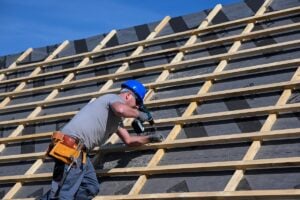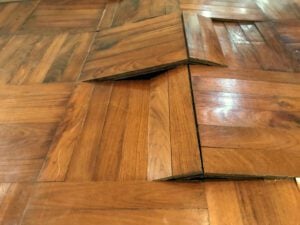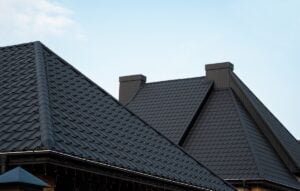Thinking about installing metal roofing? You’re not alone. Metal roofs are a durable, eco-friendly, and aesthetically pleasing option that more homeowners and businesses are turning to these days. If you’re ready to take this on as a DIY or want a clear understanding of the process before hiring a pro, this guide has you covered.
Here’s what we’ll discuss:
- Benefits of metal roofing materials
- A numbered step-by-step guide how to install metal roofing
- Common tips for a smooth installation
🤔 Why Metal Roofing?

Metal roofs are known for their durability and longevity, lasting 40-70 years with proper maintenance, significantly outlasting traditional asphalt shingles. They are also an eco-friendly option, as they are recyclable and often made from recycled materials, making them a sustainable choice for homeowners.
In addition to being durable and sustainable, metal roofs offer energy efficiency by reflecting sunlight and reducing cooling costs during hot summers. They also provide aesthetic appeal, available in a variety of finishes, colors, and styles, allowing homeowners to combine functionality with great design.
Preparing for Metal Roof Installation
Before starting any installation, preparation is key. Here’s how to get ready for the task ahead:
- Assess the Roof’s Condition: Check the roof structure to ensure it can support a metal roof. Repair any damage to trusses or the deck beforehand.
- Measure and Plan: Accurately measure your roof to determine the materials needed, minimizing waste and ensuring proper ordering.
- Gather Materials: Collect metal roofing panels, fasteners, flashing, sealant, underlayment, nails, screws, and safety gear like hard hats and harnesses.
✅ 6 Step Guide to Install Metal Roofing

Here’s your hands-on, step-by-step look at how to install metal roofing panels:
1. Install the Underlayment
Begin by laying down a waterproof underlayment across the entire roof surface. This layer acts as a crucial barrier to prevent leaks and protect your roof from water damage. Ensure the sheets of underlayment overlap by 3-4 inches, which will create a continuous, watertight seal. Secure the underlayment firmly in place using roofing nails, making sure it is applied smoothly and without gaps to provide a solid foundation for the metal panels.
2. Add Drip Edges and Flashing
Drip edges play an essential role in guiding water off your roof and preventing it from seeping into the edges of your structure. Secure these drip edges along the roof eaves, ensuring they are tightly fastened and properly aligned. Flashing, another vital component, should be installed in critical areas such as roof valleys or where the roof intersects with other structures like chimneys or walls. Flashing helps redirect water away from these vulnerable spots, minimizing the risk of leaks and water damage.
3. Lay the First Panel
Start the installation of your metal panels at the bottom corner of the roof. It is important to work your way upwards from this starting point. Align the first metal panel carefully with the roof’s edge, making sure it overhangs slightly to allow for proper drainage. Proper alignment is critical at this stage, as it will set the foundation for the placement of all subsequent panels. Take your time to ensure the first panel is positioned correctly before moving forward.
4. Secure Panels with Screws
Once the first panel is in place, it’s time to affix it securely to the roof deck. Use drill screws for this process, driving them through the panel into the roof deck. Make sure to position the screws along the raised ridges of the panel, as this helps to prevent leaks. Space the screws evenly across the panel for a uniform and secure installation. Be cautious not to overtighten the screws, as doing so can damage the panel or reduce its effectiveness in sealing against water.
5. Overlap Panels
When adding the next metal panel, position it so that it overlaps slightly with the previous panel. The amount of overlap needed is typically specified by the manufacturer, so be sure to follow their guidelines to ensure proper sealing and structural integrity. Repeat this process for each subsequent panel, carefully aligning and overlapping them as you work your way across the roof. This overlapping method ensures a seamless and watertight roof surface once all the panels are installed.
6. Install the Ridge Cap
The final step in the process is installing the ridge cap along the seams at the roof’s peak. The ridge cap serves to cover the junction where two metal panels meet, providing a finished look while also preventing water from entering at the roof’s highest point. Secure the ridge cap with screws, ensuring it is tightly fastened and properly aligned. To complete the installation, take extra care to seal the ridge cap to make it watertight, providing your roof with maximum protection against the elements.
💡 Tips for a Smooth Installation

Smooth installation ensures your product functions correctly and avoids unnecessary delays. Proper setup also prevents potential issues down the line, saving time and frustration.
Start in Good Weather
Roofing is best done on clear, dry days without any rain or snow in the forecast. Wet or icy conditions can make the roof slippery and dangerous, while also compromising the integrity of your materials during installation. Plan ahead and prioritize safety and quality by waiting for the right weather conditions.
Watch for Alignment
Proper alignment is crucial when installing roofing materials. Misaligned panels not only ruin the visual appeal of your roof but can also lead to serious issues, such as leaks and poor insulation. Take your time to line everything up carefully, measuring and double-checking as you go to ensure a professional, long-lasting result.
Use Safety Equipment
Safety should always come first when working on a roof. Equip yourself with a sturdy ladder, a reliable safety harness, and durable gloves to protect your hands. Investing in the right safety gear minimizes the risk of falls and injuries, allowing you to focus on the task at hand without unnecessary worry.
Check Manufacturer Instructions
Different roofing materials come with specific installation guidelines provided by the manufacturer. These instructions are designed to ensure the best performance and longevity for your roof. Always take the time to read and follow the directions carefully to avoid mistakes and ensure a proper installation.
📑 Metal Roofing Guide
Installing a metal roof requires precision, expertise, and a commitment to quality, and that’s exactly what you’ll find with our team at All Phase Roofing and Restoration. From expert installation to tailored solutions that enhance your home’s style and strength, we take pride in delivering durable, long-lasting results you can count on.
With years of trusted craftsmanship and a reputation for reliability, we’re the team Ohio homeowners turn to for their roofing needs. Ready to upgrade your home with a high-quality metal roof? Contact us today for a FREE roof inspection or consultation! Let us help protect your home for years to come!




